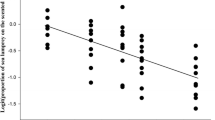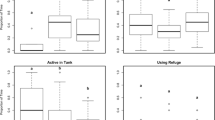Abstract
Predation is an unforgiving selective pressure affecting the life history, morphology and behaviour of prey organisms. Selection should favour organisms that have the ability to correctly assess the information content of alarm cues. This study investigated whether adult sea lamprey Petromyzon marinus habituate to conspecific damage-released alarm cues (fresh and decayed sea lamprey extract), a heterospecific damage-released alarm cue (white sucker Catostomus commersonii extract), predator cues (Northern water snake Nerodia sipedon washing, human saliva and 2-phenylethylamine hydrochloride (PEA HCl)) and a conspecific damage-released alarm cue and predator cue combination (fresh sea lamprey extract and human saliva) after they were pre-exposed 4 times or 8 times, respectively, to a given stimulus the previous night. Consistent with our prediction, adult sea lamprey maintained an avoidance response to conspecific damage-released alarm cues (fresh and decayed sea lamprey extract), a predator cue presented at high relative concentration (PEA HCl) and a conspecific damage-released alarm cue and predator cue combination (fresh sea lamprey extract plus human saliva), irrespective of previous exposure level. As expected, adult sea lamprey habituated to a sympatric heterospecific damage-released alarm cue (white sucker extract) and a predator cue presented at lower relative concentration (human saliva). Adult sea lamprey did not show any avoidance of the Northern water snake washing and the Amazon sailfin catfish extract (heterospecific control). This study suggests that conspecific damage-released alarm cues and PEA HCl present the best options as natural repellents in an integrated management program aimed at controlling the abundance of sea lamprey in the Laurentian Great Lakes.


Similar content being viewed by others
References
Bals JD, Wagner CM (2012) Behavioural responses of sea lamprey (Petromyzon marinus) to a putative alarm cue derived from conspecific and heterospecific sources. Behaviour 149:901–923
Brown GE (2003) Learning about danger: chemical alarm cues and local risk assessment in prey fishes. Fish Fish 4:227–234
Brown GE, Rive AC, Ferrari MCO, Chivers DP (2006) The dynamic nature of antipredator behavior: prey fish integrate threat-sensitive antipredator responses within background levels of predation risk. Behav Ecol Sociobiol 61:9–16
Brown GE, Elvidge CK, Ramnarine I, Chivers DP, Ferrari MCO (2014) Personality and the response to predation risk: effects of information quantity and quality. Anim Cogn 17:1063–1069
Chivers DP, Mirza RS (2001) Predator diet cues and the assessment of predation risk by aquatic vertebrates: a review and prospectus. In: Marchlewsk-Koj A, Lepri J, Muller-Schwarze D (eds) Chemical Signals in Vertebrates 9. Plenum, New York, pp. 277–284
Chivers DP, Smith RJF (1998) Chemical alarm signalling in aquatic predator-prey systems: a review and prospectus. Ecoscience 5:338–352
Chivers DP, Brown GE, Ferrari MCO (2012) The evolution of alarm substances and disturbance cues in aquatic animals. In: Hansson L-A, Bronmark C (eds) Chemical Ecology in Aquatic Systems. Oxford University Press, Oxford, UK, pp. 127–139
Ferrari MCO, Brown GE, Bortolotti GR, Chivers DP (2010) Linking predator risk and uncertainty to adaptive forgetting: a theoretical framework and empirical test using tadpoles. Proc R Soc B 277:2205–2210
Ferrero DM, Lemon JK, Fluegge D, Pashkovski SL, Korzan WJ, Datta SR, Spehr M, Fendt M, Liberles SD (2011) Detection and avoidance of a carnivore odor by prey. Proc Natl Acad Sci U S A 108:11235–11240
Imre I, Brown GE, Bergstedt RA, McDonald R (2010) Use of chemosensory cues as repellents for sea lamprey: Potential directions for population management. J Great Lakes Res 36:790–793
Imre I, Di Rocco RT, Belanger CF, Brown GE, Johnson NS (2014) The behavioural response of adult Petromyzon marinus to damage-released alarm and predator cues. J Fish Biol 84:1490–1502
Kats LB, Dill LM (1998) The scent of death: chemosensory assessment of predation risk by prey animals. Ecoscience 5:361–394
Kleerekoper H, Tayler G, Wilton R (1961) Diurnal periodicity in the activity of Petromyzon marinus and the effects of chemical stimulation. Trans Am Fish Soc 90:73–78
Kusch RC, Mirza RS, Chivers DP (2004) Making sense of predator scents: investigating the sophistication of predator assessment abilities of fathead minnows. Behav Ecol Sociobiol 55:551–555. doi:10.1007/s00265-003-0743-8
Rankin CH, Abrams T, Barry RJ, Bhatnagar S, Clayton D, Colombo J, Coppola G, Geyer MA, Glanzman DL, Marsland S, McSweeney F, Wilson DA, Wu C-F, Thompson RF (2009) Habituation revisited: an updated and revised description of the behavioural characteristics of habituation. Neurobiol Learn Mem 92:135–138
Scott WB, Crossman EJ (1998) Freshwater Fishes of Canada. Galt House Publications Ltd., Ontario, Canada
StatSoft Inc (2014) STATISTICA (data analysis software system) version 12. www.statsoft.com.
Wagner CM, Stroud EM, Meckley TD (2011) A deathly odor suggests a new sustainable tool for controlling a costly invasive species. Can J Fish Aquat Sci 68:1157–1160
Warton DI, Hui FKC (2011) The arcsine is asinine: the analysis of proportions in ecology. Ecology 92:3–10
Wisenden BD (2003) Chemically-mediated strategies to counter predation. In: Colin SP, Marshall NJ (eds) Sensory Processing in Aquatic Environments. Springer, New York, pp. 236–251
Acknowledgments
The authors are grateful to the Hammond Bay Biological Station for their logistical and housing support, especially to M. Hansen and K. Slaght. Special thanks are due to C. Belanger, R. Pietrzakowski and J. Sauvé for assistance with data collection and to M. Wagner, J. Bals and T. Meckley for allowing us to use their video camera and video recording equipment. Thanks are also due to HBBS personnel who donated human saliva for our research. This manuscript was improved by constructive comments from J. Hume. J. Foote provided feed-back on the statistical analyses. This research was supported by grants from the Great Lakes Fishery Commission, Northern Ontario Heritage Fund Corporation and the National Sciences and Engineering Research Council Undergraduate Summer Research Assistant Program. The use of experimental and tissue donor subjects were approved by the Algoma University Animal Care Committee (AUP #: 2012-II-01). This article is contribution number 1943 of the Great Lakes Science Center.
Author information
Authors and Affiliations
Corresponding author
Rights and permissions
About this article
Cite this article
Imre, I., Di Rocco, R.T., Brown, G.E. et al. Habituation of adult sea lamprey repeatedly exposed to damage-released alarm and predator cues. Environ Biol Fish 99, 613–620 (2016). https://doi.org/10.1007/s10641-016-0503-z
Received:
Accepted:
Published:
Issue Date:
DOI: https://doi.org/10.1007/s10641-016-0503-z




